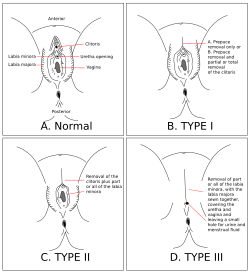Female

The World Health Organization refers to female infibulation as Type III female genital mutilation. [2] Often called "pharaonic circumcision" (or farooni) [3] in countries where it is practiced. It refers to the removal of the inner and outer labia and the suturing of the vulva. It is usually accompanied by the removal of the clitoral glans. [4] [5] The practice is concentrated in Djibouti, Eritrea, Ethiopia, Somalia, and Sudan. [1] During a 2014 survey in Sudan, over 80 percent of those who had experienced any form of FGM had been sewn closed. [6]
The procedure leaves a wall of skin and flesh across the vagina and the rest of the pubic area. By inserting a twig or similar object before the wound heals, a small hole is created for the passage of urine and menstrual blood. The legs are bound together for two to four weeks to allow healing. [7] [8]
The vagina is usually penetrated at the time of a woman's marriage by her husband's penis, or by cutting the tissue with a knife. The vagina is opened further for childbirth and usually closed again afterwards, a process known as defibulation (or deinfibulation) and reinfibulation. Infibulation can cause chronic pain and infection, organ damage, prolonged micturition, urinary incontinence, inability to get pregnant, difficulty giving birth, obstetric fistula, and fatal bleeding. [7]
